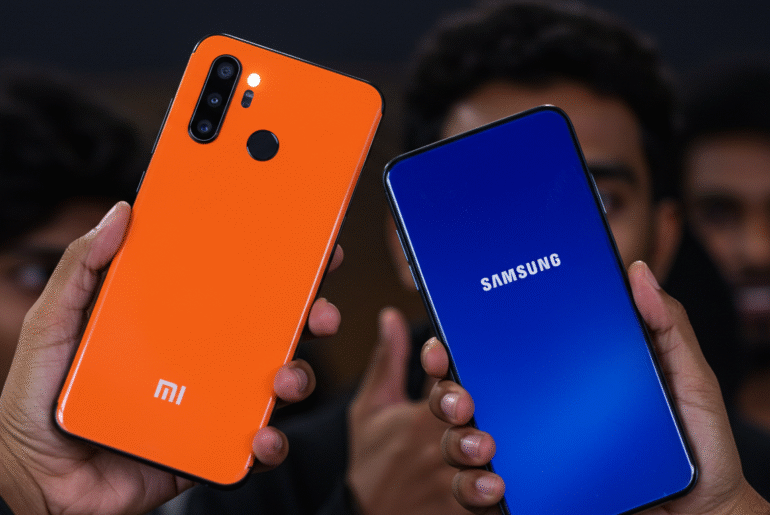This article may contain references to products or services from one or more of our advertisers or partners. We may receive compensation when you click on links to those products or services. Nonetheless, our opinions are our own.
The information presented in this article is accurate to the best of our knowledge at the time of publication. However, information is subject to change, and no guarantees are made about the continued accuracy or completeness of this content after its publication date.
- Introduction
- Xiaomi vs. Samsung Product Comparison
- What Xiaomi Phones Offer
- What Samsung Phones Offer
- Design and Feel
- Durability
- Comfort and Looks
- Updates and Support
- Side-by-Side Comparison
- Working With Other Gadgets
- Price and Value
- Customer Service
- Smartwatches, Tablets, and Smart Home Devices
- Bottom Line
- Frequently Asked Questions
- Recommended Reads
Introduction
Choosing between a new Samsung Galaxy and a Xiaomi 13 Pro can feel tricky. Both offer high-quality screens, strong batteries, and reliable features. Whether you enjoy photography, gaming, or just need a phone that works all day, comparing them side by side helps you make a smart choice. This will break down what each brand offers to help you find the phone that fits your lifestyle and budget.
Xiaomi vs. Samsung Product Comparison
Both companies produce phones, tablets, wearables, and smart devices for daily life, work, and entertainment. Samsung has a longer presence in the U.S., while Xiaomi is growing with competitive devices at lower prices. Examining their hardware, software, and cost can help you decide.
Xiaomi Products Available in the U.S.
- Phones: Redmi Note 14 Pro+ 5G, POCO F7, Xiaomi 15, 14T Pro, 14T
- Wearables: Smart Band 10, Watch S4, AI Glasses
- Tablets: Pad 7 Series
- Smart Gadgets: TVs, scooters, and the SU7 Ultra car
Samsung Products Available in the U.S.
- Phones: Galaxy Z Fold7, Flip7, S25 Ultra, S25 Series
- Tablets: Tab S10, Tab A9+
- Wearables: Watch8, Watch Ultra, Buds3, Fit3
- Home Tech: TVs, smart fridges, soundbars, and more
What Xiaomi Phones Offer
Xiaomi provides budget-friendly phones packed with features. Flagships like the 14 Ultra have strong cameras powered by Leica, fast processors, and a smooth interface with HyperOS. Users can customize settings extensively. However, some Xiaomi models may be harder to find or service in the U.S.
What Samsung Phones Offer
Samsung leads in the U.S. with its Galaxy line. These phones use Exynos processors and run One UI software, which is user-friendly. Premium models feature durable glass, metal frames, and excellent cameras. Samsung also promises long-term software updates and integrates well with other Samsung devices.
Design and Feel
Samsung phones have sleek designs with curved edges and strong glass. Xiaomi uses high-quality materials for top-tier models but often relies on plastic for budget options. Material choice impacts how the phone feels and its durability over time.
Durability
Samsung incorporates Gorilla Glass Victus and offers dust and water protection (IP68). Even lower-cost models feel sturdy. Xiaomi’s premium phones use Shield Glass 2.0, leather, or fiber backs, while cheaper models use plastic, which is less durable.
Voted "Best Overall Budgeting App" by Forbes and WSJ
Monarch Money helps you budget, track spending, set goals, and plan your financial future—all in one app.
Get 50% OFF your first year with code MONARCHVIP
Comfort and Looks
Samsung devices feel smooth and are comfortable to hold. Their Super AMOLED screens deliver sharp, bright displays. Xiaomi phones have modern designs, but larger camera modules on some models may interfere with usability. Samsung devices generally offer a more polished experience.
Updates and Support
Samsung provides seven years of updates for Galaxy S and Z phones. Xiaomi offers four years of Android updates and five years of security patches for premium devices, with lower-end models receiving fewer updates. Samsung is preferable for long-term ownership.
Side-by-Side Comparison
Compare specifications such as battery capacity, camera performance, processor type, and software experience. Checking real user reviews and testing devices in person helps you make an informed choice.
What to Check
- Performance: Review the processor type (Snapdragon or Exynos)
- Camera: Evaluate real-world photo and video quality, not just megapixels
- Battery: Consider battery life and charging speed
- Software: Choose between One UI’s simplicity or HyperOS’s customization
Working With Other Gadgets
Samsung integrates well with its watches, tablets, and smart home devices. Xiaomi also offers compatible devices, but some may have limited functionality in the U.S. Ensure your devices connect easily for a smooth experience.
Price and Value
Xiaomi provides strong features at lower prices, especially for mid-range phones. Samsung devices are costlier but tend to last longer and retain higher resale value. Look for trade-in deals and bundle offers to maximize value.
Customer Service
Samsung maintains extensive support centers and reliable warranties in the U.S. Xiaomi offers service for premium models, but support coverage is limited. Good customer service is important if repairs are needed.
Smartwatches, Tablets, and Smart Home Devices
Both brands offer connected devices. Samsung’s ecosystem is better supported in the U.S. with consistent updates. Xiaomi has innovative products, but setup and compatibility may be challenging for some users.
Bottom Line
Choosing the right phone depends on your priorities. Samsung excels in durability, updates, and support, making it ideal for long-term use. Xiaomi offers impressive features at lower prices, appealing to budget-conscious users. Evaluate performance, design, ecosystem, and cost to find the best fit for your needs.
Frequently Asked Questions
Do Samsung phones last longer?
Yes. Samsung phones are built with durable materials and receive longer software support. Xiaomi devices are good value, but budget models may not perform as well over time. Choosing premium models improves longevity. Samsung’s extended update schedule ensures features and security remain current.
Who updates faster?
Samsung generally releases updates more quickly due to close partnerships with U.S. carriers. Xiaomi updates may be slower and less predictable in the U.S. Regular updates impact security and feature improvements. Premium Samsung devices benefit most from this faster update cycle.
Are they good for gaming?
Both Xiaomi and Samsung phones perform well for gaming. Xiaomi often offers strong hardware in lower-cost phones. Samsung flagship models provide excellent displays, advanced cooling, and smooth performance. Gamers can enjoy high-quality experiences on both brands, depending on the model.
What’s the difference between MIUI and One UI?
MIUI, now HyperOS, allows extensive customization and flashy visuals. One UI offers a cleaner, simpler interface that is easy to navigate. MIUI may feel busy to some users, while One UI emphasizes usability. The choice depends on personal preference for interface style.
Which gets faster updates in the U.S.?
Samsung consistently delivers faster updates in the U.S., benefiting security and functionality. Xiaomi updates can be slower and less frequent for devices sold in the U.S. Users seeking timely software improvements may prefer Samsung devices.

Reviewed and edited by Albert Fang.
See a typo or want to suggest an edit/revision to the content? Use the contact us form to provide feedback.
At FangWallet, we value editorial integrity and open collaboration in curating quality content for readers to enjoy. Much appreciated for the assist.
Did you like our article and find it insightful? We encourage sharing the article link with family and friends to benefit as well - better yet, sharing on social media. Thank you for the support! 🍉
Article Title: Choosing Between Samsung and Xiaomi Phones in the U.S.
https://fangwallet.com/2025/08/16/choosing-between-samsung-and-xiaomi-phones-in-the-u-s/The FangWallet Promise
FangWallet is an editorially independent resource - founded on breaking down challenging financial concepts for anyone to understand since 2014. While we adhere to editorial integrity, note that this post may contain references to products from our partners.
The FangWallet promise is always to have your best interest in mind and be transparent and honest about the financial picture.
Become an Insider

Subscribe to get a free daily budget planner printable to help get your money on track!
Make passive money the right way. No spam.
Editorial Disclaimer: The editorial content on this page is not provided by any of the companies mentioned. The opinions expressed here are the author's alone.
The content of this website is for informational purposes only and does not represent investment advice, or an offer or solicitation to buy or sell any security, investment, or product. Investors are encouraged to do their own due diligence, and, if necessary, consult professional advising before making any investment decisions. Investing involves a high degree of risk, and financial losses may occur including the potential loss of principal.
Source Citation References:
+ Inspo
There are no additional citations or references to note for this article at this time.











































